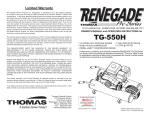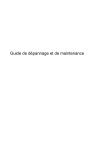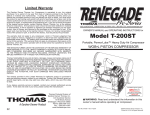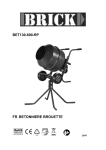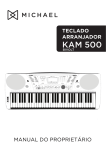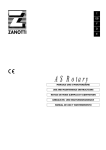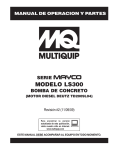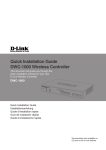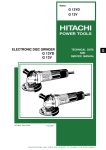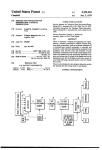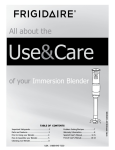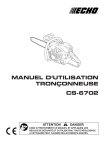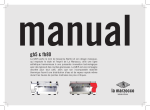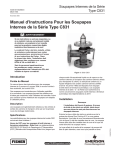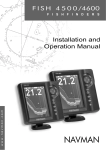Download TG-400HST - Geotech Environmental Equipment
Transcript
1419 ILLINOIS AVE., SHEBOYGAN, WI 53082 USA 800-558-7721 OWNER’S MANUAL and OPERATING INSTRUCTIONS for TG-400HST • 4.0 HONDA OHV GASOLINE ENGINE • 4 GALLONS AIR STORAGE • WOBL PISTON COMPRESSOR • 5.1 CFM @ 100 PSI • PERMA-LUBE™ COMPRESSOR DESIGN Performance, portability, and reliability makes the RENEGADE TG-400HST Series our finest, most convenient gas powered compressors. They are ideal for use in applications requiring a heavy-duty compressed air source in areas where an electrical connection is not available. For Sales & Service Contact 2650 E. 40th Ave. • Denver, CO 80205 Phone 303-320-4764 • Fax 303-322-7242 1-800-833-7958 www.geotechenv.com Part No. 642515 Rev R 08/08 ©2007 Gardner Denver Thomas Inc., Printed in U.S.A. All Rights Reserved TABLE OF CONTENTS Page # Specifications................................................................... 2 Safety First........................................................................ 3 Set-Up................................................................................ 4 Maintenance...................................................................... 5 Compressor Illustration and Parts List........................... 6 Tank Illustration and Parts List ....................................... 8 French Language Instructions......................................... 9 Compressor Troubleshooting......................................... 10 Spanish Language Instructions...................................... 15 Limited Warranty............................................................... 20 SPECIFICATIONS Air Displacement.................................................................12 CFM (340 LPM) Air Delivery........................5.1 CFM @ 100 PSI..............152 LPM @ 690 kPa) Safety Valve Setting...........................................................145 PSI (1000 kPa) Engine Idle Speed................................................................2000 ± 150 RPM Engine Run Speed...............................................................3450 ± 150 RPM Automatic Control...........................................Continuous Run Unloader Valve ....................Unloads @ 135 PSI (930 kPa).........Loads @ 115 PSI (795 kPa) Engine Oil-Recommended..................................See Engine Owner’s Manual Air Tank Capacity, ............................................................................ 4 Gallons Unit Weight................................................................................70 lbs. (32 kg) Unit Dimensions LxWxH (in)........20 X 19 X 19 (cm).................51 X 49 X 49 Compressor Type.........................Oilless Compressor, Perma-Lube™ Design Pump-Up Time............................................................. Approximately 1.5 Min. Recovery Time .........................................................Approximately 8 ± 5 Sec. Regulator Connection Size................................................................1/4 - NPT CFM = Cubic Feet Per Minute kPa = kilopascals PSI = Pounds Per Square Inch RPM = Revolutions Per Minute LPM = Liters Per Minute 2 SAFETY FIRST This symbol points out important safety instructions which if not followed could endanger the personal safety and/or property of yourself and others. Read and understand the information in this owner’s manual and the engine owner ’s manual before operating. 1. The compressor should be located in a dry, clean,and well ventilated area. 2. Inspect before use for signs of damage. Do not use if a deficiency is found. Contact your nearest service center for replacement parts. Never operate a damaged unit. 3. Do not tamper with safety valve as it has been factory set. Any adjustment of this valve could cause serious injury. 4. Compressed air must never be aimed at anyone because it can cause serious injury. Keep children away. WEAR EYE PROTECTION. 5. All air compressors generate heat under normal operating conditions. To avoid serious burns, never touch the air compressors during or immediately after operation. 6. Never run engine indoors or in enclosed, poorly ventilated areas. Engine exhaust contains carbon monoxide, an odorless and deadly gas. 7. Before servicing, cleaning, or removal of any part, stop engine and relieve air pressure. 8. This system produces 135 PSI. To avoid rupture and injury, do not operate this compressor with components rated less than 135 PSI working pressure. 9. Keep hands, feet, hair, and loose clothing away from any moving parts on engine, and compressors. 10. Do not tamper with the engine speed or air/fuel mixture. These items have been factory set. If warranty service or repairs are needed, contact your nearest authorized service center. If one does not exist contact the factory. Unauthorized repairs or teardown of the unit will void the factory warranty. 3 SETUP NOTE: The engine is shipped without oil. Add oil before use. It is recommended that you change the oil as described in your engine owner’s manual maintenance schedule. Always check the oil level before starting engine. (See engine owner’s manual for oil and fuel recommendations.) STARTING ENGINE 1. Turn fuel valve to the “ON” position. 2. Flip the engine switch to the “ON” position. 3. Place foot on base, grasp starter handle, and start engine as you would a lawn mower. Use choke if necessary. STARTING ENGINE AGAINST PRESSURIZED TANKS UNLOAD MANUAL UNLOADER VALVE 1. Move to “UNLOAD” position 2. Start engine 3. Return to “PRESSURIZE” position PRESSURIZE When STARTING the engine with air pressure in the tanks (i.e. after refueling, etc.), manually unload the compressors by moving the valve to the “UNLOAD” position, starting the engine, and then moving the valve back to the “Pressurize” position. This allows the compressors to turn freely (exhaust to atmosphere) without the back pressure of the tanks. To clean vent, remove the nut containing screen and filter with a 11/16”hex wrench. Hold under running tap water with nut toward faucet. Shake out excess water and reinstall. OPERATION The engine will start with the control lever in the “FAST’ position and will compress air until the tank pressure reaches 135 PSI. When the tank pressure reaches 135 PSI, the unloader valve will automatically actuate the throttle control causing the engine to run at idle speed, and vent the compressed air to atmosphere. When the tank pressure drops to 115 PSI, the unloader valve will reactuate the throttle control, causing the engine to run at high speed, and redirect the compressed air to the tank. WARNING: Before using air tools or accessories, check manufacturer’s maximum pressure rating. Maximum pressure rating must be above 135 PSIG. STOPPING 1. Flip the engine switch to the “OFF’ position. 2. Release air from tank. 3. Drain water from both tanks. 4. Turn fuel valve to “OFF” position. 5. Drain excess gas if compressor is to be stored indoors. (see engine owners manual). 4 WARNING: To avoid risk of tank failure during use, drain tank after each use or every four (4) operating hours to prevent condensation build up and corrosion inside tanks. To drain tank, slowly and carefully turn and open drain fittings, tip unit towards drain, and allow water to drain out. NOTE: When draining tank, watch for debris (rust particles). If there appears to be debris in the water, contact your dealer for possible tank replacement. WARNING: Do not weld on the air tanks of this compressor. Welding on the air compressor tank can severely impair tank strength and cause an extremely hazardous condition. Welding on the tank in any manner will void the warranty. If warranty service or repairs are needed contact your nearest authorized service center. If one does not exist contact the factory. Unauthorized service of the unit will void the factory warranty. MAINTENANCE AIR FILTER - COMPRESSORS Inspect compressor air filters regularly. Clean filter with soap and water as necessary. If filter becomes clogged or damaged, replace it. WARNING: Never clean air filter with a flammable liquid or solvent. Explosive vapors may accumulate in the air tank and cause an explosion, resulting in serious injury or death. CAUTION: Do not operate air compressor without air filter. CONTROL VALVE The control valve is preset at the factory to load at 115 psi and unload at 135 psi and should not require adjustment. If adjustment is necessary the unload pressure is adjusted by slightly turning the pressure adjusting nut (9/16” Hex) while holding the locking nut (5/8” Hex). Turn clockwise to increase, and counterclockwise to decrease the unload pressure. Changing the differential (the difference between the load and unload pressure) is accomplished by holding the locknut (7/8” Hex) closest to the body of the valve (so it does not move) then turning the (3/4” Hex) nut next to it very slightly clockwise to increase the differential, and counterclockwise to decrease it. ENGINE Refer to engine owner’s manual for proper maintenance procedures. CAUTION: Disconnect spark plug wire before servicing engine or compressors. ENGINE WARRANTY AND REPAIRS Engine adjustments, repairs, and warranty service are to be handled through your engine manufacturer’s authorized service centers. They are listed in your telephone book yellow pages under “ENGINES, GASOLINE”. 5 * Denotes parts included in Service Kit 1915 FOR SERVICE AND PARTS For service contact the dealer from whom you purchased the compressor. To order parts visit our website, www.thomasairpac. com or call our Customer Service Center at 1-800-848-7735. 6 626274 Part No. Washer Description COMPRESSOR ILLUSTRATION AND PARTS LIST 16 1 Qty. 1 Key 1 1 Lockwasher 1 Qty. Screw 5/16”-24 x .88 Hex Wsh Description 626035 Front Cover Engine - Honda 4.0 625275 643316 17 662405 Part No. 1 18 1 Housing - Black 4 19 Key Screw 5/16”-24 x .63” Hex Hd 1 21 625278 623075 Screw 10-32 x .38 T-20 Flt Hd O-ring 2 1 669243-540 Key Square - 3/16” x 1” 1 1 2 626275 Spring Ecc, Brg, Rod & Sleeve Assy 625397 4 627247 666433 3 5 *20 6 2 2 2 Set Screw 5/16”-18 Hex Valve Restraint 625008 Flapper Valve 7 617497 1 662563 5 *22 Valve Plate - Acrylic Coat *23 Screw 1/4”-20 x 1.25 Hex Wsh 1 662826 Piston Cup 625171 626183 *24 *8 *25 1 2 Cup Retainer Screw 1/4”-20 x .88” Flt Hd 626190 625170 2 1 1 1 Screw #10-24 x 7/8” Trx Hd O-ring Gasket Filter Head 625646 623082 664142 662545 28 1 27 *29 Cover-Filter *26 9 *10 1 1 Cylinder Sleeve Screw 10-24 7/8” 618193 625198 *11 12 7 1 Screw #10-24 x .5” Pan 1 Deflector - Cover 625192 Fan - 7 Blade 6.0” CCW 662658 14 638745 13 15 664141 1 30 31 7 TANK ILLUSTRATION AND PARTS LIST Key Part No. Description Qty. Key Part No. Descrip ion 1 604229 Hand Grip 1 11 638927 Throt le Control Qty. 1 2 669502-540 Tank Assembly - Black 1 12 625823 Screw Compressor to Base 4 3 641133 Air Regulator 1 13 638975 Safety Valve 1 4 624925 Fitting 1 14 625406 Screw, Zinc Plated 4 5 638262 Pressure Gauge 2 15 624654 Bumper-Rec W/Washer 4 6 624275 Elbow Fit ing - Female 1 16 626831 Nut 5/16” 18Hex Flange 4 7 638825 Unloader Valve 1 17 617677 Drain Cock Assembly 2 8 626831 Nut 5/16”-18 Hex Flange 4 18 624765 Elbow - Street 3/8” NPT 1 9 624961 Elbow - 3/16” 1 19 615937 Hose 13.75” 1 10 615881 Tube - Throttle 1 19 3 2 5 6 O CO 4 7 S OR 2 9 1 5 11 13 1 5 16 1 8 PRECAUTIONS D’EMPLOI ATTENTION: Veuillez lire attentivement ce manuet d’utilisation avant de vous servir de ce compresseur d’air. 1. Le compresseur doit être utilisé dans un endroit sec, pro et bien aéré. 2. Avant l’emploi, examiner le tuyau, la fiche et le fil électrique pour repére tous signes de déterioration. Ne pas utiliser l’appareil en cas de défaut de fonctionnement ou de matériel. Addressez-vous au service entretien le plus proche pour obtenir des pieces de rechange. Ne jamai sutiliser un appareil défectueux. 3. Ne pas modifier la pression de la soupape de sûreté: elle a été reglée en usine. Tout autre réglage pourrait entráiner un risque de blessure grave. 4. L’air comprimé ne doit jamais être pointé sur une personne, car il peut entráiner des blessures graves. Eloigner les enfants de l’endroit de travail. PORTER DES LUNETTES DE PROTECTION. 5. Tous les compresseurs d’air produisent de la chaleur, même dans des conditions de fonctionnement normales. Afin d’éviter les brûlures, ne jamais toucher le compresseur d’air pendant ou tout de suite aprés utilisation. 6. AVANT D’UTILISER, DE NETTOYER OU DE RETIRER TOUT ACCESSOIRE, DEBRANCHER L’APPAREIL ET REDUIRE LA PRESSION. 2 7. CE SYSTEME PEUT PRODUIRE 9,5 kg/cm (135 PSI). POUR EVITER TOUTE RUPTURE POUVANT ENTRAINER DES BLESSURES, NE PAS UTILISER CETTE POMPE AVEC DES ACCESSOIRES PREVUS POUR UNE PRESSION INFERIEURE A 9,5 kg/cm2 (135 psi) (Y COMPRIS MAIS NON LIMITE AUX PISTOLETS A PEINTURE.TUYAUX ET RACCORDS DESTUYAUX. 8. Ne faites jamais marcher le moteur à l’intérieur ou dans endroits mal aérés. Le moteur laisse échapper de l’oxyde de carbone, un gaz mortel sans odeur. 9. Gardez mains, pieds, cheveux et vêtements flottants à distance des parties mobiles du moteur et du compresseur. 10.Ne changez pas la vitesse du moteur et ne touchez pas aux controôes de mélange d’air/carburant. Ceux-ci out été réglés en usine. • MOTEUR À ESSENCE DE 4,0 CV • RÉSERVOIR D’AIR DE 4 GAL. • 5.4 CFM @100 PSI • CONCEPTION PERMA-LUBE™ 9 10 Resistance in throttle control Resistance in throttle linkage Engine won’t return to high speed Compressor recovers fast Compressor slow to recover Safety valve blows open and engine won’t return to idle Air leak Hand unloader in “UNLOAD” position Worn piston cup and/or sleeve Broken flapper valve Compressor won’t build pressure Throttle cable out of adjustment Control valve set incorrectly Air tanks full of water Worn piston cup and/or sleeve Resistance in throttle control Resistance in throttle linkage Throttle cable out of adjustment Air leak Engine run speed too low Control valve set incorrectly Control valve set incorrectly Refer to Control Valve section or instructions to set correctly Drain water from tanks Adjust throttle cable by removing the attachment screw and turning the attachment clip (clip is threaded) Use a solution of soapy water to find leak Turn run speed adjustment screw (CCW)-See engine manual Refer to Control Valve section for instructions to set correctly Adjust throttle cable by removing the attachment screw and turning the attachment clip (clip is threaded) Remove head and valve plate to inspect. Replace if needed Clean and lubricate the cable casing and control cylinder Loosen friction nut on the throttle linkage of the engine With compressor running, adjust control valve by loosen the won’t return to idle 9/16” hex while holding the 5/8” jam hex. Loosen slowly-1/8 turn at a time Clean and lubricate the cable casing and control cylinder Loosen friction nut on the throttle linkage of the engine Use a solution of soapy water to find leak Move to “LOAD” position Remove head and valve plate to inspect, replace if needed Remove head and valve plate to inspect, replace if needed Move hand unloader to “UNLOAD” position while starting Air pressure in the tank/s Recoil starter pulls very hard Defective low oil sensor switch Refuel Add oil Turn switch to “ON” Turn valve to “ON” Turn off choke and pull starter until excess fuel is removed Replace spark plug Check spark across plug gap Inspect and replace if needed, filter should be clean and dry Check by disconnecting the wires of the sensor. See authorized engine service center for repairs Out of gasoline Oil level low Switch is in off position Fuel valve is in off position Engine flooded Bad spark plug No spark Engine air filter, wet, clogged or dirty Engine won’t start REMEDY POSSIBLE CAUSE SYMPTOM TROUBLESHOOTING GUIDE Engine speed fluctuates Engine idle speed too low Engine run with choke on Spark plugs wet or fouled Engine is running out of fuel Engine idles for long periods Refer to Control Valve section of instructions to set correctly Control valve set incorrectly Incorrect cut-in/cut-out pressure Refuel Adjust idle speed to 2200 rpm +/- 150 rpm Set choke to run position when engine is running Increase idle speed to 2200 rpm +/- 150 rpm or replace spark plug with a spark plug that is one heat range “otter”- see authorized engine service center Add oil Place on level surface, check oil level, drain if necessary Adjust idle speed to 2200 rpm +/- 150 rpm Clean and lubricate the cable casing and control cylinder Loosen friction nut on the throttle linkage of the engine Adjust run speed to 3450 rpm +/- 150 rpm Adjust idle speed to 2200 rpm +/- 150 rpm Clean and lubricate the cable casing and control cylinder Loosen friction nut on the throttle linkage of the engine Adjust throttle cable by removing the attachment screw and turning the attachment clip (clip is threaded) Thighten bolts that connect engine to base plate of tank Oil level low Too much oil in engine Engine idle speed too low Resistance in throttle control Resistance in throttle linkage Loose engine bolts Throttle cable out of adjustment Resistance in throttle control Resistance in throttle linkage Engine speed out of adjustment Engine quits Excessive vibration Changing the differential (the difference between the load and unload pressure) is accomplished by holding the locknut (7/8” Hex) closest to the body of the valve, then turning the differential nut (3/4” Hex) very slightly. Turn clockwise to increase and counterclockwise to decrease the differential. If adjustment is necessary, the unload pressure is adjusted by slightly turning the pressure adjusting nut (9/16” Hex) while holding the locking nut (5/8” Hex). Turn clockwise to increase and counterclockwise to decrease the unload pressure. For service contact the dealer from whom you purchased the compressor. To order parts visit our website, www.thomasairpac.com or call our Customer Service Center at 1-800-848-7735. Control Valve Setting Instructions The control valve is preset at the factory to load at 115 psi and unload at 135 psi and should not require adjustment. 11 Performance mobilité et fiabilité font de RENEGADE® TG-400 le meilleur et le plus commode de nos compresseurs à moteur essence. Idéal dans les applications exigeant une source d’air comprime très puissante dans des lieux où n’y a pas d’électricité. Ce symbole . . . = Ce symbole est là pour indiquer d’importantes instructions de sécurité qui peuvent mettre en danger votre sécurité et celle des autres ainsi que votre propriété et/ou celle des autres si elles ne sont pas suives. Lire et comprendre les informations se trouvant dans ie manuel de l’utilisateur et dans ie manuel du moteur avant de faire marcher cet appareil. Lire et comprendre les informations se trouvant dans ie manuel de l’utilisateur et dans ie manuel du moteur avant de faire marcher cet appareil. AVANT LA MISE EN ROUTE NOTE: Le moteur est expédié sans huile. Mettez de l’huile avant de l’utiliser. II vous est recommandé de changer l’huile comme indiqué dans le calendrier d’entretien de votre manuel du moteur. Toujours vérifier le niveau d’huile avant de mettre en route le moteur. (Voir le manuel du moteur pour les recommandations en matière d’huile et de carburant). DÉMARRAGE DU MOTEUR 1. Ouvrez la valve de carburant (ON). 2. Mettre la clé de contact du moteur sur “ON” (marche). 3. Placer le pied sur la base de la machine, prendre la poignée du démarreur et demarrer le moteur comme vous le (eriez avec une tondeuse. DÉMARRAGE DU MOTEUR CONTRE LES RÉSERVOIRS RESSURISÉS VALVE MANUELLE DU DECHARGEUR Pressuriser 1. Mettre sur “UNLOAD” (Décharger) 2. Mettre en route le moteur 3. Revenir sur “PRESSURIZE“ (Pressuriser) “UNLOAD” = Décharger Décharger “PRESSURIZE” = Pressuriser Lorsque VOUS DÉMARREZ le moteur avec de la pression d’air dans les réservoirs (par exemple, après avoir fait le plein, etc. . . . ), déchargez manuellement les compresseurs en mettant la valve sur “UNLOAD” (Décharger), en démarrant le moteur et ensuite en remettant la valve sur “PRESSURE” (Pression). Cela permet aux compresseurs de tourner librement (évacuation à l’air libre) sans la pression des réservoirs. FONCTIONNEMENT Le moteur démarrera avec le levier de contrôle sur FAST (Rapide) et comprimera l’air jusqu’à ce que la pression du réservoir atteigne 135 PSI. Lorsque la pression du réservoir atteint 135 PSI, la valve du déchargeur activera automatiquement la commande de l’accelerateur mettant le moteur au ralenti et éventera l’air comprimé dans l‘atmosphere. Lorsque la pression du réservoir tombe à 115 PSI, la valve du déchargeur activera la commande d’accélératuer, ce qui fera tourner le moteur à vitesse élevée et redirigera l’air comprimé dans le réservoir. 12 AVERTISSEMENT: Avant d’utiliser des outils ou des accessoires à air comprimé, vérifier la pression maximum mentionnée par le fabricant. Cette pression maximum doit être supérieure à 135 PSIG. POUR ARRETER LE MOTEUR 1. Mettre la clé de contact sur “OFF” (Arrêt). 2. Relácher l’air du réservoir. 3. Vidanger l’eau des deux réservoirs. 4. La valve du combustible du tour à “FERMÉ” place. 5. Vidanger l’excés d’essence, si le compresseur doit être remisé à l’intérieur d’un bâtiment (voir ie manuel du moteur). AVERTISSEMENT: Pour éviter le risque de panne de réservoir pendant l’usage, vidanger le réservoir après chaque utilisation ou toutes les quatre (4) heures de marche pour empêcher l’apparition de condensation et de corrosion à l’intérieur des réservoirs. Pour vidanger un réservoir, tourner lentement et soigneusement les bouchons de vidange. Incliner la machine du côté de la vidange et laissez l’eau sortir. REMARQUE: Lorsque vous vindangez un réservoir, regardez si des débris sortent de celui-ci. Si c’est le cas, contactez votre concessionnaire pour éventuellement remplacer le réservoir. AVERTISSEMENT: Ne pas faire de soudure sur les réservoirs à air de ce compresseur. Le fait de souder-sur ce compresseur peut réduire sérieusement la résistance du réservoir et provoquer une condition extrêmement dangereuse. Toute soudure effectuée sur les réservoirs annulera la garantie. Si un entretien ou des réparations sont nécessaires pendant la garantie, contactez votre concessionnaire agréé le plus proche. S’il n’y en a pas, contactez l’usine. Tout modification non-autorisée de la machine annule la garantie d’usine. ENTRETIEN FILTRE À AIR - COMPRESSEURS Inspecter régulièrement les filtres à air du compresseur. Nettoyer le filtre avec du savon et de l’eau selon les besoins. Éliminez l’excès d’humidité du filtre et laissez-le sécher avant de le remettre en place. Si le filtre se bouche ou est endommagé, le remplacer. AVERTISSEMENT: Ne jamais nettoyer un filtre à air avec un liquide inflammable ou du solvant. Des vapeurs explosives peuvent s’accumuler dans le réservoir d’air et causer une explosion, avec, pour conséquences, de graves blessures ou la mort. ATTENTION: Ne pas faire marcher le compresseur sans filtre à air. 13 MOTEUR Se reporter au manuel du moteur pour les procédures correctes d’entretien. REMARQUE: Débranchez ie fil de la bougie avant de faire l’entretien du moteur, de la courroie ou des compresseurs. GARANTIE ET REPARATIONS DU MOTEUR Les réglages, réparations et service de garantie du moteur doivent être effectués par les centres de service agréés du fabricant du moteur. Vous en trouverez la liste dans votre annuaire téléphonique à la rubique “Moteur à essence”. SPÉCIFICATIONS Déplacement d’air................................................... 12 CFM (340 LPM) Débit d’air.....................5.1 CFM à 100 PSI..........................(152 LPMà 690 kPa) Reglage de la valve de securite ............................ 145 PSI (1000 kPa) Vitesse de ralenti du moteur ............................. 2000 ± ou - 150 RPM Vitesse de marche du moteur............................ 3450 ± ou - 150 RPM Commando automatique .... Valve de déchargeur en marche continue .......Décharge à 135 PSI (930 kPa)..........Charge à 115 PSI (795 kPa) Hulle de moteur recommandée .................... Voir ie manuel du moteur Volume des réservoirs d’air ................................................... 4 gallons Poids de la machine ...................................................... 70 Ibs. (32 kg) Dimensions Long. x larg. x haut. (pouces) ...................... 20 X 19 X 19 (cm) ......................................51 X 49 X 49 Type de compresseur ................................ .............. Compresseur sans huile ......................................................Conception Perma lube™ Temps de pompage ............................................ 90 ± ou-5 secondes Temps de récupération ....................................... 8 ± ou - 5 secondes Dimension de la connexion du régulateur ............... 1/4 de pouce NPT CFM = Pieds cubiques par minute LPM = Litres par minute PSI = Livres par pouce carré kPa = kilopascals RPM = Tours par minute 14 REGLAS PARA UNA OPERACION SEGURA PRECAUCION: Antes de operar el compressor de aire, lea este manual del propietario y asegurese de comprender la informacion aqui contenida. 1.EI compresor debe ubicarse en una zona seca, limpia y bien ventilada. 2. Inspeccione el compressor antes de su uso. No se use si se encuentra una deficiencia o senales de dano. Contacte a su centro de servicio mas cercano para obtener partes de repuesto. 3. El ajuste de la valvula de alivio de seguridad ha sido fijado en la fábrica. No lo altere. Los ajustes de esta valvula pueden provocar lesiones graves. 4. El flujo de aire comprimido no debe dirigirse a ninguna persona porque puede provocar lesiones graves. No permitaque se acerquen los niños. UTILICE PROTECTORES PARA LOS OJOS. 5.Todos los compresores de aire generan calor, aun bajo condiciones de operación normales. Para evitar quemaduras graves no toque el cabezal ni los componentes del escape del compresor durante la operación o inmediatamente después de ella. 6. Nunca opere el motor en interiores o areas con poca ventilacion. Los gases de escape del motor contienen monoxido de carbono, un gas inodoro y letal. 7. Antes del servicio, la limpieza o el desmontaje de cualquier pieza, ague la unidad y alivie la presion. 8. Este sistema puede producir hasta 9,5 kg/cm2 (135 psi). Para evitar rupturas de componentes y lesiones, no opere la unidad con accesorios cuya presion nominal de trabajo sea inferior a 9,5 kg/cm2 (135 psi). 9. Mantenga las manos, pies, cabello y ropa floja alejados de las piezas en movimiento del compresor y de la máquina. 10. No altere la velocidad del motor o la mezcla de aire-combustible. Esos parametros han sido fijados de fabrica. 15 Si se requieren reparaciones o servicio de garantia, póngase en contacto con el centro de servicio autorizado más cercano. Si no dispone de un centro, póngase en contacto con la fábrica. Las reparaciones, o el desmontaje de la unidad sin autorización anularán la garantía de fábrica. • MAQUINA DE GASOLINA DE 4.0 CABALLOS DE FUERZA • 4 GALONES DE ALMACENAMIENTO DE AIRE (H) • 5.1 CFM A 100 PSI • COMPRESOR DE PISTONES WOB-L® • DISEÑO PERMA-LUBE™ El rendimiento, la transportabilidad y la seguridad hacen del RENEGADE TG-400 nuestro mejor y mas conveniente compresor operado con gasolina. Es ideal para usarse en aplicaciones que requieran de una fuente de aire comprimido de alto poder donde una conexión eléctrica no se encuentra disponible. Este simbolo señala importantes instrucciones de seguridad las cuales si no se siguen, pueden, poner en peli gro la seguridad personal y/o las pertenencias de usted y otros. Lea y entienda la información en este manual del propietario y el manual del propietario de la máquina antes de ponerse en operación. Lea y entienda la información en este manual del propietario y el manual del propietario de la máquina antes de ponerse en operación. PREPARACION NOTA: La máquina ha sido enviada sin aceite. Agréguele aceite antes de usarla. Se recomienda que cambie el aceite como se describe en el plan de mantenimiento del manual del propietario de la máquina. Siempre cheque el nivel del aceite antes de echar a andar la máquina. (Vea el manual del propietario de la máquina sobre recomendaciones para aceite y combustible.) PARA ARRANCAR LA MÁQUINA 1. Ponga la válvula de combustible en ON (encendido). 2. Mueva el interruptor de la máquina a la posición de“ENCENDIDO” (ON, en inglés). 3. Coloque el pie en la base, sujete el mango de arranque y arranque la máquina como si arrancara una segadora de pasto. 16 PARA ARRANCAR LA MÁQUINA CONTRA TANQUES PRESURIZADOS VÁLVULA DE DESCARGA MANUAL 1. Mueva a la posición de “DESCARGAR” (UNLOAD, en inglés) 2. Arranque la máquina 3. Regrese a la posición de “PRESURIZAR” (PRESSURIZE, en inglés) DESCARGAR PRESURIZAR Cuando ARRANQUE la máquina con aire a presión en los tanques (por ejemplo, después de cargar combustible, etc), descargue los compresores manualmente moviendo la válvula a la posición de “DESCARGAR”, arranque la máquina y luego regrese la valvula a la posición de “PRESION” (PRESSURE, en inglés). Esto permite que los compresores den vueltas libremente (con escape a la atmósfera) sin la contrapresion de los tanques). OPERACION La máquina arrancará con la palanca de control en la posición de “RAPIDO” (Fast, en inglés) y comprimirá el aire hasta que la presión del tanque alcance 135 PSI. Cuando la presión del tanque alcanza 135 PSI, la válvula de descarga automáticamente activará el control de la impulsión, lo que causará que la máquina corra a una velocidad en vacío y ventile el aire comprimido a la atmósfera. Cuando la presión del tanque disminuye a 115 PSI, la válvula de descarga reactivará el control de la impulsión, lo que causará que la máquina corra a alta velocidad y dirija el aire comprimido al tanque. PRECAUCION: Antes de usar herramientas de aire o accesorios, revise la clasificación de presión máxima del fabricante. La clasificación de presión máxima deberá de estar por arriba de 135 PSIG. 17 APAGADO 1. Mueva el interrupter de la máquina a la posición de “APAGADO” (OFF, en inglés). 2. Saque el aire del tanque. 3. Drene el agua de ambos tanques. 4. Gire la valvula de combustible a la posicion de “APAGADO” (OFF in Ingles). 5. Drene el exceso de gasolina si el compresor se va a almacenar en un lugar interior (vea el manual del propietario de la máquina). PRECAUCION: Para evitar el riesgo de falla del tanque durante su uso, drene el tanque después de cada vez que se use o cada cuatro (4) horas de operación para evitar el acumulamiento de condensacion y la corrosión dentro de los tanques. Para drenar el tanque, abra las valvulas de drenaje despacio y con cuidado. Incline la unidad hacia la valvula y espere hasta que el agua salga del tanque. NOTA: Cuando drene el tanque, tenga cuidado con desechos (partículas de óxido). Si parece que hay desechos en el agua, comuníquese con su distribuidor para la posibilidad de reemplazar el tanque. PRECAUCION: No solde en los tanques de aire de este compresor. El soldar en el tanque compresor de aire puede dañar severamente la resistencia del tanque y causar una situación extremadamente peligrosa. El soldar en el tanque de cualquier manera nulificará la garantía. Si necesita servicio de garantîa o si necesita reparaciones, comuníquese con su centro de servicio autorizado mas cercano. Si no existe alguno, comuníquese con la fábrica. El desmantelamiento de launidad no autorizado nulificará la garantía de fabrica. MANTENIMIENTO FILTRO DE AIRE - COMPRESORES Inspeccione los filtros de aire del compresor regularmente. Limpie el filtro con agua y jabón cuando sea necesario. Apriete el filtro para eliminar el exceso de humedad y deje que se seque antes de volverlo a instalar.Si el filtro se tapa o se daña, cámbielo. VALVULA DE CONTROL La valvula de control es fijada de fabrica para cargar el tanque a 115 psi y para descargar a 135 psi, y no debe requerir ajuste. Si ajuste es necesario. la presion de descarga es ajustada al girar ligeramente la tuerca de ajuste de presion (9/16” hexagonal) mientras se sostiene la tuerca de seguridad (5/8” hexagonal). Gire en el sentido de las manecillas del reloj para incrementar y en sentido opuesto para disminuir presion de carga. El cambio del diferencial (la diferencia entre la presion de carga y descarga) se logra sosteniendo la tuerca de seguridad (7/8” hexagonal) cerca del cuerpo de la valvula (para que no se mueva), despues girando la tuerca (3/4” hexagonal) muy despacio en sentido de las manecillas del reloj para disminuirlo. 18 PRECAUCION: Nunca limpie el filtro de aire con un solvente o líquido inflamable. Se pueden acumular vapores explosives en el tanque de aire y causar una explosión, lo queresulta en serias heridas o la muerte. PRECAUCION: No opere el compresor de aire sin el filtro de aire. MAQUINA Consulte el manual del propietario de la máquina para los procedimientos de mantenimiento apropiados. NOTA: Desconecte el cable de la bujía antes de dar servicio a la máquina o a los compresores. GARANTIA DE LA MAQUINA Y REPARACIONES Los ajustes de la máquina, reparaciones y servicio de garantía se deben manejar por medio de sus centros de servicio autorizados del fabricante de su máquina. Están enlistados en la sección amarilla de su directorio telefónico bajo “máquinas, gasolina”. ESPECIFICACIONES Desplazamiento de Aire ............................................................... 12 CFM (340 LPM) Rendimiento de Aire .................... 5.1 CFM a 100 PSI.............. (152 LPM a 690 kPa) Ajuste de la Válvula de Seguridad ................................................145 PSI (1000 kPa) Velocidad de Marcha en Vacío de la Máquina ................................. 2000 ± 150 RPM Velocidad de Marcha de la Máquina ................................................ 3450 ± 150 RPM Control Automático ................................. Válvula descargadora de Marcha Continua ............................ Descarga a 135 PSI (930 kPa) ....................................Carga a 115 PSI (795 kPa) Aceite para Máquina-Recomendado ................................... Consulte el Manual del Propietario de la Máquina Capacidad delTanque deAire ......................................................................4 Galones Peso de la Unidad ................................................................................ 70 Ibs (32 kg) Dimensiones de la Unidad LxAxA ...............................(in) .....................20 X 19 X 19 (cm) ...................51 X 49 X 49 Tipo de Compresor .................................................................... Compresor sin Aceite Diseño PermaLube™ Tiempo de Bombeo ........................................................................................ 1. 5 Min Tiempo de Recuperación............................................................................ 8 ± 5 Seg Tamaño de la Conexión del Regulador .......................................................... 1/4 NPT CFM = Pies Cúbicos Por Minuto LPM = Litros Por Minuto PSI = Libras Por Pulgada Cuadrada RPM = Revoluciones por Minuto kPa = kilopascales 19 Limited Warranty The Gardner Denver Thomas, Inc. Compressor is warranted to you, the original purchaser, for a period of one year from date of original purchase to be free from defects in material and workmanship. If during the specified warranty period you believe the purchased product or any part thereof has such a defect, you must return the product or part during such period, with proof of purchase and at your cost, to the nearest authorized service center (consult the list of service centers enclosed with the product) for repair, or replacement of the defective part. If you do not know the location of the nearest service center, contact Gardner Denver Thomas, Inc. at the address below for instructions. If the product or part is found to have been defective in material or workmanship, it will be repaired or replaced (as deemed necessary by the repair center), free of charge, and returned to the purchaser at the purchaser’s cost. If the repair work must be done at the Gardner Denver Thomas, Inc. factory, transportation costs of the product or part, to and from the factory, must be paid by the purchaser. The warranty shall not apply to any compressor, which in Thomas’ judgement has been subject to misuse, negligence or accident, or which has been operated from an inadequate power supply. All wearing and consumable parts are excluded under the terms of this warranty. This warranty shall not apply to compressors that require oil for operation, which have been operated with oil levels below that specified by Gardner Denver Thomas, Inc. THE MANUFACTURER LIMITS THE DURATION OF THE IMPLIED WARRANTY OF MERCHANTABILITY TO THE LIMITED WARRANTY PERIOD SET FORTH ABOVE, AND OTHERWISE DISCLAIMS ALL IMPLIED WARRANTIES WITH RESPECT TO THE PRODUCT AND IT’S PARTS INCLUDING, WITHOUT LIMITATION, THE IMPLIED WARRANTY OF FITNESS FOR A PARTICULAR PURPOSE. Thomas’ total liability for any and all claims, damages, losses and injuries arising out of or relating to any breach of warranty shall not exceed the purchase price of the product. IN NO EVENT WHETHER IN CONTRACT, OR TORT, OR OTHERWISE SHALL THOMAS BE LIABLE FOR LIQUIDATED, INDIRECT, EXEMPLARY, INCIDENTAL, SPECIAL OR CONSEQUENTIAL DAMAGES, EXPENSES OR COSTS, INCLUDING BUT NOT LIMITED TO: (1) LOSS OF PROFITS, BUSINESS, OR GOODWILL; (2) LOSS OF USE OF EQUIPMENT OR FACILITIES; OR (3) LOSS RESULTING FROM UNUSABLE MACHINERY OR FACILITY DOWNTIME, HOWSOEVER CAUSED AND EVEN IF THE POTENTIAL FOR SUCH DAMAGES WAS DISCLOSED AND/OR KNOWN. The remedy provided in this Limited Warranty for defective product is purchaser’s sole and exclusive remedy, subject to your state law. Further, this Warranty gives you specific legal rights, and you may also have other rights, which may vary, from state to state. If you believe warranty service is needed, contact your nearest authorized service center. If one does not exist in your area, please contact the manufacturer: Thomas Products Division C/O Customer Service 3524 Washington Avenue Sheboygan, Wisconsin 53081 Phone: (800) 848-7735 Fax: (920) 451-6307 www.thomasairpac.com





















